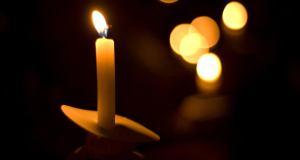Six years after the upside-down Christmas tree trend took over the 2017 holiday season, it seems holiday lovers are still just as divided on the unique Christmas décor. As families began to hang mistletoe and deck the halls in preparation of Santa Claus’s arrival, the trees once again are disrupting the holiday spirit.
“Upside down Christmas trees piss me off & idk why,” one person candidly wrote on X (formerly Twitter). It seems that social media user is not alone in their disdain for the trend, with another person writing, “if you have an upside down christmas tree i should be legally permitted to crop dust ur house.” That same person went on to add in a follow-up post, “i hate that they exist.”
Videos by PopCulture.com
The upside-down Christmas tree trend took off in 2017. At the time, social media flooded with posts of people opting for the unusual Christmas décor, a trend that was met with a fiery response on social media. Six years later, it seems the trend is still going strong, with several major retailers currently offering upside-down Christmas trees. On Walmart’s website, there is an upside-down Christmas tree list for $130, with Big Lots offering a seven-foot Spruce upside-down Christmas tree for nearly $400. Meanwhile, Bed Bath & Beyond has a listing for an orange upside-down Christmas tree for just above $150.
“I just learned that some people get ‘upside down’ Christmas trees, and I have to ask, why??” one social media user wrote after coming across one of the trees while online shopping. Another person dubbed the trend, “the ugliest thing I have ever seen,” with somebody else asking, “Why would you buy an upside down christmas tree.”
While there is plenty of opposition to upside-down Christmas trees, it’s important to note that it’s not entirely new. Upside-down Christmas trees actually trace back to the Middle Ages, where they were used in Central and Eastern Europe, The Spruce reports. According to the outlet, European Christians would hang their fir trees upside down at Christmastime to represent the Holy Trinity.
Along with throwing a new topsy-turvy twist to the Christmas season, these upside-down trees actually solve some serious problems. Not only do they take up less floor space, which means more territory for presents to be set out, but they also allow for the majority of ornaments to be kept out of the reach of children and pets.









